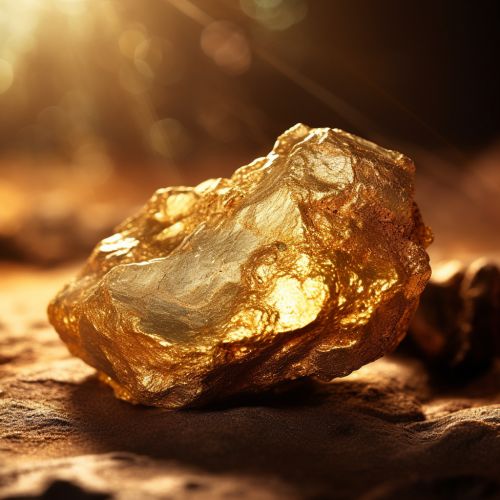Gold
Introduction
Gold is a chemical element with the symbol Au (from Latin: aurum) and atomic number 79, making it one of the higher atomic number elements that occur naturally. In its purest form, it is a bright, slightly reddish yellow, dense, soft, malleable, and ductile metal. Chemically, gold is a transition metal and a group 11 element. It is one of the least reactive chemical elements and is solid under standard conditions.
Physical Properties
Gold is the most malleable of all metals. It can be drawn into a monoatomic wire, and then stretched about twice before it breaks. Such nanowires distort via formation, reorientation and migration of dislocations and crystal twins without noticeable hardening. A single gram of gold can be beaten into a sheet of 1 square meter, and an avoirdupois ounce into 300 square feet. Gold leaf can be beaten thin enough to become semi-transparent. The transmitted light appears greenish blue, because gold strongly reflects yellow and red. Such semi-transparent sheets also strongly reflect infrared light, making them useful as infrared (radiant heat) shields in visors of heat-resistant suits, and in sun-visors for spacesuits.


Chemical Properties
Gold is unaffected by air and most reagents. It is insoluble in nitric acid, which dissolves silver and base metals, a property that has long been used to refine gold and to confirm the presence of gold in metallic objects, giving rise to the term acid test. Gold also dissolves in alkaline solutions of cyanide, which are used in mining and electroplating. Gold dissolves in mercury, forming amalgam alloys, but this is not a chemical reaction.
History
Gold has been used as a symbol for purity, value, royalty, and particularly roles that combine these properties. Gold as a sign of wealth and prestige was ridiculed by Thomas More in his treatise Utopia. On that imaginary island, gold is so abundant that it is used to make chains for slaves, tableware, and lavatory seats. When ambassadors from other countries arrive, dressed in ostentatious gold jewels and badges, the Utopians mistake them for menial servants, paying homage instead to the most modestly dressed of their party.
Economic Role
Gold is used in a variety of industries due to its unique physical and chemical properties. Its high malleability, ductility, resistance to corrosion and most other chemical reactions, and conductivity of electricity have led to its continued use in corrosion resistant electrical connectors in all types of computerized devices (its chief industrial use). Gold is also used in infrared shielding, colored-glass production, gold leafing, and tooth restoration. Certain gold salts are still used as anti-inflammatories in medicine.
Cultural Significance
In many cultures, gold is synonymous with wealth and prosperity and has been used in artwork for thousands of years. The beauty of gold, its rarity, and its resistance to tarnish made it an ideal material for crafting objects of art, religious artifacts, and jewelry. Gold has also been used in dental technology for around 3000 years. The Etruscans in the 7th century BC used gold wire to fix in place substitute teeth. The ancient Egyptians also made crowns and bridges from gold.
